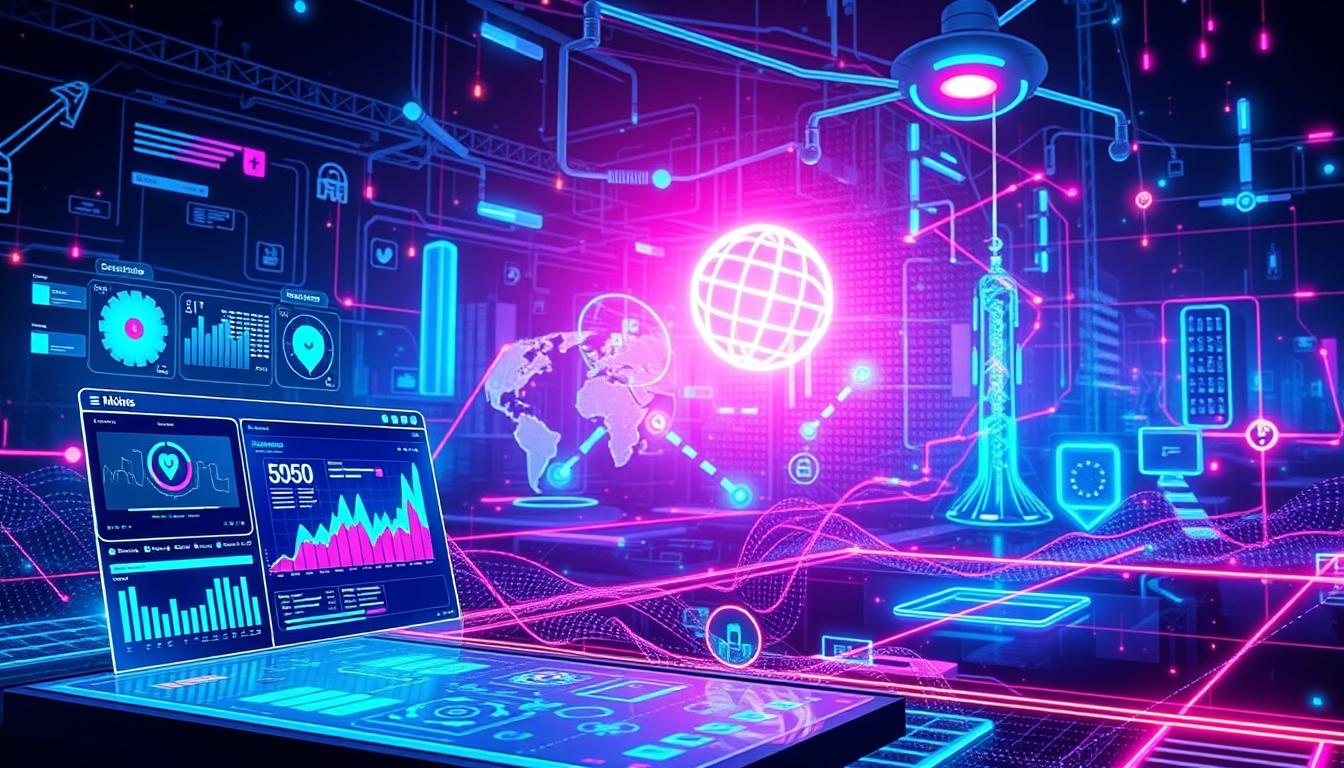Are you ready to revolutionize your digital marketing strategy? With the rapid evolution of technology, the way businesses interact with customers is changing dramatically. The question on every marketer’s mind is: what’s next?
The world of digital marketing is undergoing a significant transformation due to the advent of emerging technologies. These innovations are not only changing how businesses market their products and services but also how they engage with their audience.
As we explore the latest digital marketing trends, it’s clear that staying ahead of the curve is crucial for success. In this article, we’ll delve into the emerging technologies that are reshaping the industry.
Key Takeaways
Table of Contents
- Understanding the impact of emerging technologies on digital marketing
- Exploring the latest digital marketing trends
- Learning how to leverage new technologies for marketing success
- Discovering the role of AI, AR, VR, blockchain, IoT, and machine learning in digital marketing
- Building a technology roadmap for future marketing success
The Digital Marketing Technology Landscape in 2023
The digital marketing landscape is undergoing a significant transformation in 2023, driven by emerging technologies. As businesses strive to stay ahead of the curve, understanding the current technology landscape is crucial.
Key Technology Drivers Reshaping Marketing Strategies
Several key technology drivers are reshaping marketing strategies in 2023. These include:
- AI in Marketing: Artificial intelligence is being used to personalize customer experiences, predict behaviors, and automate marketing processes.
- AR in Digital Marketing: Augmented reality is creating immersive experiences, enhancing customer engagement and brand recall.
- Machine Learning in Digital Marketing: Machine learning algorithms are being used to analyze vast amounts of data, providing valuable insights that inform marketing strategies.
These technologies are not only improving the efficiency of marketing operations but also opening up new avenues for customer interaction and brand storytelling.
Assessing Your Current Technology Stack
To leverage these emerging technologies effectively, marketers need to assess their current technology stack. This involves:
- Evaluating existing tools and platforms to identify areas for improvement.
- Determining how current infrastructure can be optimized or upgraded to support new marketing strategies.
- Identifying opportunities to integrate new technologies with existing systems.
By taking a comprehensive approach to assessing their technology stack, businesses can ensure they are well-positioned to capitalize on the latest trends in digital marketing.
How to Implement AI in Your Marketing Strategy
In today’s fast-paced digital landscape, leveraging AI can be the key differentiator for successful marketing campaigns. As marketers, understanding how to effectively integrate AI into our strategies is crucial for staying ahead of the competition.
Setting Up AI-Powered Customer Analytics
Implementing AI starts with gaining deeper insights into customer behavior. AI-powered customer analytics tools can process vast amounts of data to identify patterns and predict future customer actions. This enables marketers to make data-driven decisions, enhancing campaign effectiveness.
Tools and Platforms for AI Implementation
Choosing the right tools is vital for successful AI integration. Marketers can select from a variety of platforms that offer AI-powered analytics, such as Google Analytics 360 and Adobe Sensei. These platforms provide advanced capabilities like predictive analytics and customer segmentation.
| Platform | Key Features | Integration |
|---|---|---|
| Google Analytics 360 | Predictive analytics, customer segmentation | Google Ads, Google Cloud |
| Adobe Sensei | AI-powered content analysis, customer journey mapping | Adobe Experience Cloud |
Deploying Chatbots for Lead Generation and Customer Service
Chatbots are another effective way to leverage AI in marketing. They can be used for lead generation by engaging potential customers in personalized conversations. Additionally, chatbots enhance customer service by providing immediate responses to customer inquiries.
Creating Personalized Content with AI Tools
AI tools enable marketers to create highly personalized content. By analyzing customer data, AI can help tailor messages to individual preferences, improving engagement and conversion rates. This level of personalization was previously unattainable without extensive manual analysis.
By implementing these AI-driven strategies, marketers can significantly enhance their campaign effectiveness and customer engagement. As AI technology continues to evolve, staying informed about the latest trends and tools will be crucial for ongoing success.
Leveraging Augmented and Virtual Reality for Immersive Marketing
Immersive marketing through AR and VR is becoming a cornerstone of innovative marketing strategies, enabling brands to connect with their audiences in entirely new ways. By leveraging these technologies, marketers can create engaging, interactive experiences that not only capture attention but also drive customer loyalty and conversion.
Steps to Create Your First AR Marketing Campaign
To create an effective AR marketing campaign, start by defining your objectives and understanding your target audience. Determine what actions you want users to take when interacting with your AR experience. Next, design an engaging AR experience that aligns with your brand and objectives. Utilize platforms and tools that simplify the development process, such as ARKit for iOS devices or ARCore for Android devices.
Measuring AR Campaign Performance
To gauge the success of your AR campaign, track key performance indicators (KPIs) such as engagement rates, conversion rates, and user retention. Analyzing these metrics will help you refine your strategy and improve future campaigns.
| KPI | Description | Example Metric |
|---|---|---|
| Engagement Rate | Percentage of users who interact with the AR experience | 25% |
| Conversion Rate | Percentage of users who complete a desired action | 10% |
| User Retention | Percentage of users who return to the AR experience | 40% |
Developing Virtual Reality Experiences for Customer Engagement
Virtual Reality (VR) offers a fully immersive experience, allowing customers to engage with your brand in a controlled, interactive environment. To develop a VR experience, identify the goals you want to achieve, such as increasing brand awareness or providing product demonstrations. Then, design an immersive experience that meets these objectives, utilizing VR hardware and software solutions.
Key considerations for VR experiences include:
- Comfort and usability to prevent user fatigue
- Interactive elements to encourage engagement
- Storytelling to create an emotional connection
AR/VR Integration with Existing Marketing Channels
To maximize the impact of AR and VR, integrate these technologies with your existing marketing channels. This can include embedding AR experiences within social media campaigns or using VR in conjunction with email marketing initiatives. By doing so, you can create a cohesive, multi-channel marketing strategy that leverages the strengths of both traditional and immersive marketing techniques.
Emerging Technologies in Digital Marketing: Blockchain Applications
In the rapidly changing landscape of digital marketing, blockchain technology stands out for its potential to enhance transparency and security. As we explore the applications of blockchain in this field, it becomes clear that its impact is multifaceted, offering innovative solutions for advertisers, marketers, and consumers alike.

Implementing Transparent Ad Verification with Blockchain
One of the significant challenges in digital advertising is ensuring the authenticity and effectiveness of ad spend. Blockchain technology offers a solution by providing a transparent and tamper-proof ledger for ad verification. This means that every step of the ad delivery process can be tracked and verified, reducing the risk of fraud and ensuring that advertisers get the value they pay for.
To implement blockchain for ad verification, businesses can partner with platforms that specialize in blockchain-based ad verification. These platforms use smart contracts to automate the verification process, ensuring that ads are delivered as intended and that payments are made accordingly.
Creating Loyalty Programs Using Smart Contracts
Loyalty programs are a crucial aspect of customer retention strategies, but they can be complex and costly to manage. Smart contracts on blockchain platforms offer a streamlined way to create and manage loyalty programs. By automating the reward process and making it transparent, businesses can enhance customer trust and engagement.
To create a loyalty program using smart contracts, businesses first need to define the terms and conditions of the program. This includes specifying the actions that earn rewards and the nature of the rewards themselves. The program is then implemented on a blockchain platform, where the smart contract automates the distribution of rewards based on the predefined rules.
Steps to Accept Cryptocurrency Payments
Accepting cryptocurrency payments is another way businesses can leverage blockchain technology. Cryptocurrencies offer a secure and efficient way to process transactions, reducing the need for intermediaries and lowering transaction fees.
To start accepting cryptocurrency payments, businesses need to set up a digital wallet and integrate it with their payment processing system. This involves choosing a cryptocurrency, setting up the wallet, and configuring the payment gateway. Businesses should also consider the regulatory and tax implications of accepting cryptocurrency payments.
Harnessing IoT and Machine Learning for Data-Driven Marketing
The integration of IoT and machine learning is revolutionizing data-driven marketing by providing unprecedented customer insights. As businesses continue to adopt IoT devices, the volume of data generated is becoming increasingly vast, offering a rich source of information for marketers. By leveraging machine learning algorithms to analyze this data, companies can uncover patterns and preferences that were previously unknown.
Collecting and Analyzing IoT Data for Customer Insights
IoT devices, from smart home appliances to wearables, generate a continuous stream of data. By collecting and analyzing this data, marketers can gain a deeper understanding of customer behaviors and preferences. For instance, a smart thermostat manufacturer can analyze usage patterns to identify peak usage times and tailor marketing campaigns accordingly.
Key steps in collecting and analyzing IoT data include:
- Identifying relevant IoT devices and data sources
- Implementing data collection mechanisms
- Applying machine learning algorithms to analyze the data
Building Predictive Models with Machine Learning
Machine learning enables marketers to build predictive models that forecast customer behaviors and preferences. By training these models on historical data, businesses can anticipate future trends and adjust their marketing strategies proactively.
For example, a retailer can use machine learning to predict which customers are likely to churn based on their purchase history and browsing behavior. This allows the retailer to implement targeted retention strategies.
Tools for Implementing Machine Learning in Marketing
Several tools are available to help marketers implement machine learning in their strategies. Some popular options include:
| Tool | Description | Key Features |
|---|---|---|
| TensorFlow | An open-source machine learning library | Flexible, scalable, and widely adopted |
| Google Analytics 360 | A comprehensive analytics platform | Predictive analytics, audience segmentation |
| Adobe Sensei | AI and machine learning framework | Personalization, predictive analytics |
As noted by Andrew Ng, “AI is the new electricity.”
“Just as electricity transformed industries, AI is now doing the same, and marketing is no exception.”
Creating Connected Customer Experiences Across Devices
By integrating IoT data with machine learning insights, businesses can create connected customer experiences across devices. For example, a customer’s interaction with a smart speaker can be linked to their mobile app usage, enabling a seamless and personalized experience.
Conclusion: Building Your Technology Roadmap for Future Marketing Success
As we’ve explored throughout this article, emerging technologies are transforming the digital marketing landscape. To achieve future marketing success, businesses must build a technology roadmap that incorporates these emerging technologies in digital marketing.
By assessing current capabilities, identifying areas for improvement, and strategically adopting new technologies such as AI, AR/VR, blockchain, IoT, and machine learning, marketers can stay ahead of the curve and deliver innovative marketing strategies that drive engagement, conversion, and customer loyalty.
Staying up-to-date with the latest digital marketing trends is crucial in this rapidly evolving landscape. By doing so, businesses can capitalize on new opportunities, improve customer experiences, and ultimately drive revenue growth.
By building a comprehensive technology roadmap, businesses can ensure they’re well-positioned to take advantage of emerging technologies and stay ahead of the competition in the ever-changing digital marketing landscape.
FAQ
What are the emerging technologies transforming digital marketing?
Emerging technologies such as AI, AR, VR, blockchain, IoT, and machine learning are transforming digital marketing by enabling businesses to personalize customer experiences, predict behaviors, and automate processes.
How can AI be implemented in a marketing strategy?
AI can be implemented in marketing by setting up AI-powered customer analytics, deploying chatbots for lead generation and customer service, and creating personalized content with AI tools.
What is the role of AR and VR in digital marketing?
AR and VR are revolutionizing digital marketing by offering immersive experiences that captivate and retain customer attention, enabling businesses to engage with their customers in new and innovative ways.
How can blockchain technology be used in digital marketing?
Blockchain technology can be used in digital marketing for transparent ad verification, creating loyalty programs using smart contracts, and accepting cryptocurrency payments, enhancing security, transparency, and efficiency.
What is the significance of IoT and machine learning in data-driven marketing?
IoT and machine learning are crucial in data-driven marketing as they enable businesses to collect and analyze vast amounts of data, build predictive models, and create connected customer experiences across devices, driving engagement and personalization.
How can businesses build a technology roadmap for future marketing success?
Businesses can build a technology roadmap by assessing their current capabilities, identifying areas for improvement, and strategically adopting emerging technologies such as AI, AR/VR, blockchain, IoT, and machine learning to stay ahead of the curve.


